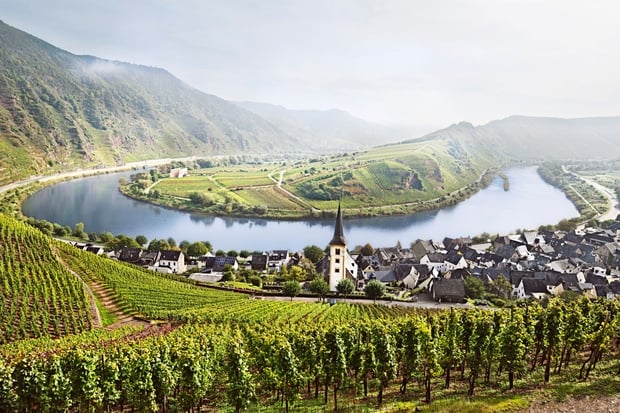Germany is often associated with its beers, but its wine heritage is just as impressive. German grape varieties offer a diversity of unique flavors and aromas that deserve a place in your collection. From the famous Riesling to more confidential varieties, Germany's foreign wines seduce with their quality and their ability to accompany a wide range of dishes.
Germany, an exceptional wine-growing region
Germany enjoys ideal conditions for vine-growing.
- Cool climate: Moderate temperatures favor slow ripening of the grapes.
- Varied soils: Schist, limestone or sandstone bring unique nuances to the wines.
- Key regions: Moselle, Rheingau and Franconia produce some of Germany's finest grape varieties.
This combination produces Riesling and other varietal wines with lively acidity and complex aromas.
Germany's emblematic grape varieties
1. Riesling: the king of German wines
Riesling is undoubtedly Germany's most famous grape variety.
- Caractéristiques: Notes of citrus, peach, sometimes minerality.
- Various styles: dry, semi-dry or sweet, depending on region and producer.
- Ideal with: Seafood, Asian dishes or fruit desserts.
- Why add it? Riesling wines offer great diversity and exceptional ageing potential.
2. Spätburgunder: German Pinot Noir
Spätburgunder, the equivalent of Pinot Noir, produces elegant, fine reds.
- Caractéristiques: Notes of cherry, strawberry and sweet spices.
- Styles: Light red or slightly woody, depending on vinification.
- Ideal with: Simmered dishes, poultry or mild cheeses.
3. Silvaner: a historic grape variety
Silvaner has been cultivated for centuries in Germany, and is still an essential grape variety.
- Characteristics: Freshness, herbaceous and mineral notes.
- Styles: Dry and lively, perfect as an aperitif.
- Perfect with: Asparagus, white fish or vegetarian dishes.
4. Grauburgunder: German Pinot Gris
This grape variety, known as Pinot Gris, produces rich, aromatic wines.
- Caractéristiques: Notes of yellow fruit, almond and honey.
- Ideal with: Foie gras, poultry or creamy dishes.
5. Müller-Thurgau: a versatile grape variety
Müller-Thurgau is appreciated for its ease of cultivation and light wines.
- Characteristics: Floral and fruity notes, low acidity.
- Ideal with: Salads, light aperitifs or seafood.
Germany's must-see wine regions

1. Moselle
The Moselle is famous for its steep slopes and pure Riesling wines.
- Soil: Schist, ideal for mineral wines.
- Flagship wines: Dry Rieslings and late harvest.
2. Rheingau
The Rheingau produces elegant wines with good acidity.
- Main grape varieties: Riesling and Spätburgunder.
- Special features: Exceptional vintages, perfect for ageing.
3. Franconia
Franconia is famous for its iconic flat bottles.
- Main grape varieties: Silvaner, Müller-Thurgau.
- Style: Dry, structured wines.
Why collect German wines?

1. Exceptional diversity
German grape varieties offer a wide range of styles, from dry to sweet.
2. Impressive storage capacity
Riesling wines, in particular, age beautifully, developing complex aromas over time.
3. Excellent value for money
Compared to other great European wines, foreign wines from Germany are often affordable.
How to choose German wines for your collection?
1. Choose well-known producers
Estates such as Egon Müller and Robert Weil guarantee consistent quality.
2. Explore late harvest
These wines, made from overripe grapes, offer elegant smoothness and exceptional ageing potential.
3. Vary your grape varieties
Don't hesitate to diversify your collection with varieties such as Silvaner or Spätburgunder.
Food and wine pairings with German grape varieties
1. Riesling
- Pairings: Seafood, sushi, spicy Asian dishes.
- Tip: A semi-dry Riesling goes well with fruity desserts.
2. Spätburgunder
- Pairings: Red meats, game or simmered dishes.
- Tip: Serve slightly chilled to reveal its freshness.
3. Silvaner
- Serve with: Salads, asparagus, white fish.
- Tip: Ideal for light or vegetarian meals.
Current trends in German wines
1. Back to traditional practices
Many winegrowers opt for biodynamic methods that respect the environment.
2. Exploring little-known terroirs
Regions such as Palatinate and Baden are gaining in popularity thanks to their fine wines.
3. Rise in sparkling wines
German sparkling wines, known as Sekt, seduce with their freshness and attractive price.
Conclusion: add German grape varieties to your cellar
German grape varieties offer an aromatic richness and diversity that will enrich your collection. From Riesling, the king of whites, to Spätburgunder, elegant and fine, each grape variety tells its own unique story. Explore Germany's varied terroirs to discover quality foreign wines, perfect for every occasion.
If you enjoyed this article, you may also be interested in "How to combine wines and spices for successful pairings"!





